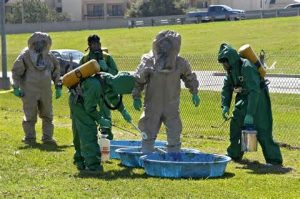 HAZWOPER is short for Hazardous Waste Operation and Emergency Response. Emergency responders or operations likely to encounter hazardous waste partake in this training.
HAZWOPER is short for Hazardous Waste Operation and Emergency Response. Emergency responders or operations likely to encounter hazardous waste partake in this training.In the modern day office, chemicals, cleaners, solvents, mold, mildew, pesticides,
or just poorly filtered recycled air can impact health issues.
or just poorly filtered recycled air can impact health issues.
All employees need minimal training in hazardous waste. Some examples:
- Employee changes a nine volt battery and discards the dead cell in the trash can.
o One of the top causes of ignition is nine vault batteries thought to be dead, and the two terminals contact the same piece of metal. A circuit is completed and the battery heats up igniting other trash. Electric tape over the two terminals wrapped around the battery prevents this problem.
- Employee cleans the bathroom with bleach. Next employee cleans the bathroom with ammonia. The combination causes toxic gas fumes.
o Schedule cleaning with specific chemicals and procedures.
- Plastics or chlorinated compounds, such as solvents, heat up releasing phosgene gas. Phosgene gas kills unmercifully by burning lung tissue.
o Store chemicals properly and be aware of dangerous combinations which should never be stored together.
- Instruct all employees in HAZWOPER awareness. In a chemical environment, even in an office, combinations of inks, solvents, cleaners, heat and poor storage habits can create unhealthy conditions quickly.
- Create standard operating procedures for all cleaning and maintenance chores to avoid incorrectly disposing of waste products.
- Choose products which are easily recycled, for example ink cartridges. Recycling avoids combining chemicals in the trash can.
- Inspect your building for mold and mildew and remediate the smallest colony before it grows. Professionally inspect your duct work at least annually and pre-treat for biological hazardous material. Using positive pressure (pumping clean filtered air into your building) can reduce the biological intrusion through cracks and air seeps throughout your building.
- On line or in classroom instruction is available to create awareness and provide knowledge for all employees.
- Awareness: your best defense against environmental hazards.





